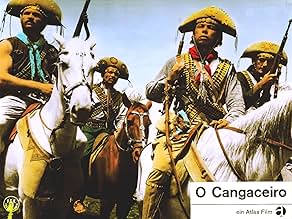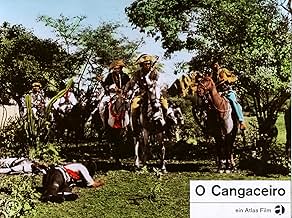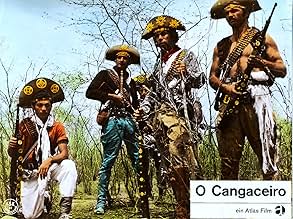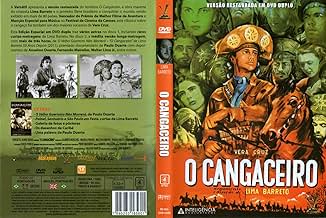अपनी भाषा में प्लॉट जोड़ें'Capitão', a bandit, terrorizes poor villages in the Northeast region of Brazil, looting and frequently killing with his armed gang, until he kidnaps and becomes attracted to a beautiful sch... सभी पढ़ें'Capitão', a bandit, terrorizes poor villages in the Northeast region of Brazil, looting and frequently killing with his armed gang, until he kidnaps and becomes attracted to a beautiful schoolteacher, creating discord in his group.'Capitão', a bandit, terrorizes poor villages in the Northeast region of Brazil, looting and frequently killing with his armed gang, until he kidnaps and becomes attracted to a beautiful schoolteacher, creating discord in his group.
- पुरस्कार
- 2 जीत और कुल 1 नामांकन
फ़ीचर्ड समीक्षाएं
10joel-280
Like the few great sci-fi, western, and other genre films, O Cangaceiro transcends its genre to speak of integrity and how people deal with awful contradictions and dilemmas that develop in their lives. Sometimes unsuccessfully.
But don't let my fancy talk deter you; it's a great movie and if somehow you have a chance to see it, don't miss it. It is a three-star attraction (meaning, "worth a trip.")
To meet the IMDb's length requirement, I'll also note its poetic photography, deservedly famous background music, and the cool, restrained treatment (aided by the b&w photography) of deep emotions and tragic events.
But don't let my fancy talk deter you; it's a great movie and if somehow you have a chance to see it, don't miss it. It is a three-star attraction (meaning, "worth a trip.")
To meet the IMDb's length requirement, I'll also note its poetic photography, deservedly famous background music, and the cool, restrained treatment (aided by the b&w photography) of deep emotions and tragic events.
Another great film that is characterised by a memorable music score. Not all films with great music are great films, but haunting or otherwise memorable scores are a feature of so many of the greatest films of all time - The Third Man, Jeux Interdits, High Noon, American Graffiti, most of the Kubrick opus, Who's Afraid of Virginia Woolf and probably any documentary adopting Philip Glass' minimalism (The Thin Blue Line and The Fog of War) being prominent examples. This is so even when the music is not original but simply selected and edited in from classical music, popular or folk songs, as appropriate and evocative. Bets are that you won't be able to get the title folk song of O Cangaceiro out of your head for some time after you've finished watching it - it seems to affect every viewer that way.
This is a film reminiscent of The Wages of Fear, in its portrayal of poverty and the brutality, especially towards women, traditionally endemic in South America. No wonder Claude Levi-Strauss entitled his seminal ethnographic work based on travels in South America "Tristes Tropiques".
I had been warned of the brutality of the horse-dragging scene in this film - yet I can only say that it pales into insignificance with the graphic closing horse-dragging scene of The Cowboys - when I guess John Wayne was, as his career closed, ever more drawn to reactionary law-and-order neanderthalism.
A melancholic film with great B/W cinematography and even better music, depicting that eternal South American atmosphere of brutality and tragic sadness. A rare film well worth watching.
This is a film reminiscent of The Wages of Fear, in its portrayal of poverty and the brutality, especially towards women, traditionally endemic in South America. No wonder Claude Levi-Strauss entitled his seminal ethnographic work based on travels in South America "Tristes Tropiques".
I had been warned of the brutality of the horse-dragging scene in this film - yet I can only say that it pales into insignificance with the graphic closing horse-dragging scene of The Cowboys - when I guess John Wayne was, as his career closed, ever more drawn to reactionary law-and-order neanderthalism.
A melancholic film with great B/W cinematography and even better music, depicting that eternal South American atmosphere of brutality and tragic sadness. A rare film well worth watching.
Beautifully photographed, this Brazilian variation on the western is a strange mix. On the positive sides the images are very striking, and there are scenes of emotional intensity and violence, especially around the film's climax that are amazingly well staged and acted.
On the other hand, there's not a lot of depth to any of the characters or their motivations. They're more archetypes than full people. (It also falls into that cliché of the better looking an actor is, the better human being his character is.) Certainly that's common in this genre, but it doesn't mean I have to like it.
The story is nothing that new. Yet it's presented with a fierceness and focus that makes it very watchable. These bandit anti-heroes are hard men with hard hearts. Their violence is still disturbing, even by modern standards.
The much discussed music fell on both sides of the fence to me. The score, which includes a lot of songs, is sometimes quite a haunting partner to the striking images. But at other times, when the group of bandits whose story this is fall into singing and dancing in ways that feel more akin to a musical than a gritty, violent western, the effect was odd and disconcerting, almost unintentionally comic. But that might just be a cultural bias - it took me a while to get used to the musical numbers in Bollywood films, for example.
Overall, this was a film I was glad I got to see, and would like to see again for its imagery. Also, now that I understand its style, some of the cultural quirks would be less likely to throw me off balance.
On the other hand, there's not a lot of depth to any of the characters or their motivations. They're more archetypes than full people. (It also falls into that cliché of the better looking an actor is, the better human being his character is.) Certainly that's common in this genre, but it doesn't mean I have to like it.
The story is nothing that new. Yet it's presented with a fierceness and focus that makes it very watchable. These bandit anti-heroes are hard men with hard hearts. Their violence is still disturbing, even by modern standards.
The much discussed music fell on both sides of the fence to me. The score, which includes a lot of songs, is sometimes quite a haunting partner to the striking images. But at other times, when the group of bandits whose story this is fall into singing and dancing in ways that feel more akin to a musical than a gritty, violent western, the effect was odd and disconcerting, almost unintentionally comic. But that might just be a cultural bias - it took me a while to get used to the musical numbers in Bollywood films, for example.
Overall, this was a film I was glad I got to see, and would like to see again for its imagery. Also, now that I understand its style, some of the cultural quirks would be less likely to throw me off balance.
10elmar5
I saw this movie as an adolescent in the 60es just once on TV, but it still is one of only a handful which surface at least once every five years. As other reviewers have pointed out before, the great music by Zé do Norte was a major factor for this memorability. Foremost here is the ballad "Mulher Rendeira" (The Lacemaker), especially in the unforgettable scene when the gang rides in a duck line along a ridge which is set against the dusk sky and the gloomy grandeur of the Brazilian Sertao. In their leather garments, pepped up by the symbolism of amulets and talismans, the bandidos in this movie resemble an archaic tribe living in this land of dust and thorns for eons already. The movie is filmed in black and white which is lending it a certain kind of credibility reminding of a documentary. Although presenting a different plot, Barreto's movie was obviously inspired by the fate of the most famous couple of Brazilian cangaceiros, Lampiao and his wife Maria Bonita, who were killed in 1938 with seven others of their gang by the police.
I keep a very impressing souvenir of this picture I saw (6 times) in the fifties and would extremely appreciate if anyone could help me in finding a video copy. I much appreciated the crude and natural poetry of the film and,of course, the wonderful music. The photography also impressed me quite a lot and in my opinion Lima Barreto could have been influenced by Carol Reed. By all means, this film can certainly compete with the best "westerns" and should be given a chance to touch the actual generation by means of video, DVD etc. Although, since then, we have larger screens and color, this kind of picture in black and white proves, if necessary, that masterpieces exists without that.
क्या आपको पता है
- ट्रिवियाThe very first Brazilian film to compete at the Cannes Film Festival.
- कनेक्शनEdited into A Edição do Nordeste (2023)
टॉप पसंद
रेटिंग देने के लिए साइन-इन करें और वैयक्तिकृत सुझावों के लिए वॉचलिस्ट करें
विवरण
- चलने की अवधि
- 1 घं 45 मि(105 min)
- रंग
- ध्वनि मिश्रण
- पक्ष अनुपात
- 1.37 : 1
इस पेज में योगदान दें
किसी बदलाव का सुझाव दें या अनुपलब्ध कॉन्टेंट जोड़ें





















